giant owl, pale owl (Caligo memnon) Description
English: Caligo memnon - dorsal view.
Date 17 April 2011
Author Greg Hume
Source: https://commons.wikimedia.org/wiki/File:Caligo_memnon_15.jpg
Caligo memnon, the giant owl or pale owl, is a butterfly of the Nymphalidae family. The species can be found in the rainforests and secondary forests of Mexico down to the Amazon rainforest. The wingspan is usually from 115 to 130 mm, but can reach 150 mm. Considered a subspecies of Caligo telamonius (C. & R. Felder, 1862). Order: Lepidoptera, Family: Nymphalidae, Genus: Caligo, Species: Caligo memnon (C. & R. Felder, [1867]).
Synonyms:
Pavonia telamonius C. & R. Felder, 1862
Caligo telamonius
Caligo telamonius memnon
